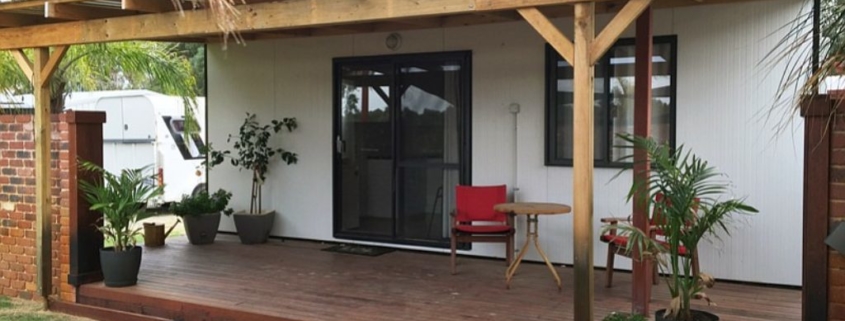Granny Flats in No Time Flat
As the California housing crisis continues to expand, more and more Californians are looking for ways to leverage their property into additional revenue streams. With popular options like Airbnbs and short term rentals generating controversy and uncertainty as of late, an alternative way for families to supplement their main sources of income is on the rise: the Accessory Dwelling Unit.
An Accessory Dwelling Unit, or “ADU” is a rentable secondary dwelling unit with complete living facilities for one or more persons. They are alternatively known as Granny Flats, In-Law Units, Backyard Cottages and Secondary Units. The ADU can be attached to the primary residence, detached, or even converted within the primary house itself, such as a garage or basement.
The concept of an ADU or Granny Flat is nothing new or ground breaking. ADUs have been around for a while, but, until recently, they were largely cost prohibitive due to the fees associated with zoning and administrative costs, in addition to the strict requirements to which ADUs were required to adhere. This changed in January of 2017 when Governor Jerry Brown signed a law (SB 1069) that aimed to help homeowners more easily build and rent out ADUs on their single family residential properties.
Prior to the new law, ADUs were regulated at the county and city level. Zoning laws at this level were extremely restrictive with respect to where ADUs could be built, their size and many other burdensome requirements. The new state law, on the other hand, is far laxer in its approach to ADUs. For example, under the former San Diego regulations related to ADUs, one of the biggest hurdles for homeowners was the requirement of an additional parking space. Not only was the additional parking space required, but further complicating matters were additional restrictions as to where the new space was required to be located with respect to the ADU. The new California ADU legislation makes it easier for any lot zoned with a single-family residence to add a secondary unit because it relaxes or eliminates many of these types of restrictions.
Moreover, as long as the ADU meets applicable zoning guidelines, the new ADU Legislation allows homeowners to expand their units without having to get a conditional use permit (a “CUP”). The CUP requirement alone was a significant barrier to entry into the ADU landscape for many homeowners due to the many restrictions that accompany it, in addition to the significant resources required to push the CUP through San Diego’s confounding bureaucratic process.
The new California law effectively cuts through much of the old red tape that was associated with San Diego’s prior ADU regulations, which in turn has led to a sharp reduction in the fees required to build ADUs. That is not to say that building an ADU is easy or cheap—the construction costs necessary to attach water, electricity and sewer systems will be more than enough to dissuade many people. However, for now, the only real financially limiting factor lies with construction costs. In the future, it is quite possible that the City of San Diego will create pre-approved design templates that will accelerate approvals and limit the architecture and construction costs associated with future ADUs.
This change to ADU legislation comes at a time when San Diego has become one of the most expensive housing markets in the United States. The mayor’s office reported that more than 70% of San Diegans cannot afford to buy a home at the county’s median home cost, which is around $575,000. Coupled with this is the reality that rent in San Diego has sky rocketed to reach more than $1,887 a month. Allowing more in San Diego to construct and use an ADU will help alleviate some of the financial strain that comes with homeownership or renting. With respect to homeownership, ADUs will obviously be a source of supplemental income to the homeowner and increase the home’s overall value. As for prospective renters, there should be an increase in the supply of rental units as a result of a boom in ADU construction, which should help match the strong demand.
However, there are negatives to consider as well. Adding an ADU to a property can come with a substantial increase to your utility bills depending on who moves in. Additionally, if you add an ADU to an existing investment property (i.e. a secondary home that one is renting out already), then you can typically expect longer vacancy periods in both properties if both are unoccupied. This is likely due to renter’s not wanting to move in unless they’re sure they’re going to get along with their not so distant neighbors. Finally, adding an ADU to an existing investment property will likely force you to lower the rent in the main house to accommodate for the loss in space. These issues are not insurmountable by any means, but they will be deal-breakers to some.
From a policy perspective, California’s decision to overrule city and county oversight on ADUs may present challenges for local municipalities. Widespread adoption of the ADU legislation will increase the densities in many urban areas in a manner that was not planned for by the municipality. As ADUs are adopted, many areas will experience overcrowding in schools, traffic, and increased crime unplanned by local governments. The hope is that the adoption of ADUs will be slow enough that cities will be able to build infrastructure to keep pace with increasing densities.
Another policy byproduct is that the ADU legislation has further made homeownership for non-investors more difficult. As mentioned above, housing units with ADUs will command higher prices. For non-investors who are not in the business of renting homes, an ADU is not necessary or desirable, let alone affordable. As the number of homes with ADUs increase, those homes are effectively removed from the market for the non-investor home buyer. By eliminating barriers for ADUs, California has ostensibly again made the decision to favor the investor homeowner over the primary residence homeowner.
Whether or not the new California ADU legislation will have a meaningful impact on housing and rental costs in San Diego remains to be seen. Though it’s not for everybody, as there are costs and potential problems to consider, it does remain an attractive opportunity for those looking to leverage their property to create an additional income stream.
For your reference here are the main new California requirements for ADUs:
- The property must be zoned single family and there must be an existing single-family residence already built;
- The ADU is not its own property such that the ADU can only be rented, but not sold, separate from the main residence;
- Generally speaking (there are exceptions), the ADU’s square footage must be no more than 1,200 square feet and no less than 150 square feet. However, the ADU’s square footage cannot exceed 50% of the main residence’s living area;
- The ADU can be attached, detached or converted within the existing residence;
- No additional parking space(s) required if (1) the ADU is within a half mile to a transit stop; (2) the ADU is part of the existing permitted residence or structure; OR (3) the ADU is within a historic district.
- If the ADU does not fall within one of the foregoing categories, the additional parking is limited to one per unit or per bedroom, and such parking space can be in existing driveway or tandem spaces.






